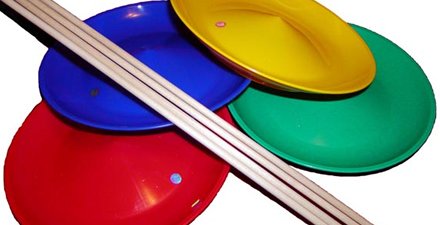
5: The Spinning Earth: As the Plate Tilts

Summary: Having studied the nature of light and the properties of shadows, in this Activity students will connect these insights to their observations of their own shadows at different times of day, concluding that a rotating Earth can explain the changes in shadows they observed in the previous Activity, "Changes in Shadows," and, with them, the motion of the Sun observed in the first Activity. To model the changing shadow of a standing person on a rotating Earth, they will use straws extending vertically from a plate. The students will be asked to imagine that the straws represent a person, and relate their observations of the shadows to what this person would perceive. In this sense, this Activity begins the process of relating different points of view of the same phenomenon, which will be a crucial ingredient in the following Activities.
Science:
- Objective 3.01 Observe that light travels in a straight line until it strikes an object and is reflected and/or absorbed
Math:
- Objective 3.01 Use appropriate vocabulary to compare, describe and classify two and three-dimensional figures.
Arts:
- Objective 2.01 Use meta-cognitive strategies to comprehend text (e.g reread, read ahead, ask for help, adjust reading speed, question, paraphrase, retell).
Pre-Req Knowledge
Students' experience in the previous activities should have given them a clear understanding of the relations between a light source, an object, and its shadow. Their experiences in the previous activity will have taught them how the size and direction of the shadow of a vertical object, such as a person, is related to that person's observation of the Sun's position in the sky and to the time of day as measured by that person. This lesson will often draw upon these two critical ideas, and if these concepts are not clear yet it would be a good idea to recapitulate them before the lesson.
Pre-Activity Assessment
- Can you explain how a shadow changes size when the object creating it is moved closer or further from the light?
- Do you remember what happened to your shadow or the stick's shadow in the shadow tracing activity as the day went on? What caused the shadow to change positions, and how did the shadow change?
After this activity, students should be able to:
- Explain how moving or rotating an object in the path of a light ray changes its shadow.
- Show that pointing a vertical object towards a light source makes the object's shadow small, while rotating it to be perpendicular to the light source causes the shadow to be long.
- Explain where the sun is around morning, noon, and sunset, and explain why their shadow is different shapes at these times.
- Demonstrate with their plate what morning, noon, and sunset would look like if they pretended the plate was the earth, the golf tee was their body and the light source at the center of the room was the sun.
- Understand and demonstrate how the straw "person" would experience sunrise, noon, sunset, and night, translating their point of view from "outside" the plate-world to that of its denizens.
- Show that rotating their plate causes a transition from an imaginary morning, through noon and sunset, to night for the straw on their plate.
- Draw a parallel between their plate and the earth, and explain the conclusion that our earth's rotation is like the plate's and that shadows caused by the sun in fact change because the earth is always rotating.
Activity Assessment
- The student should be able to follow the Directions worksheet and attempt to answer all its questions.
- Can the students demonstrate how moving or rotating their plate is making the shadow change? Can they show how to make the shadow smaller and how to make it larger?
- Is the connection between the plates and the Earth clear? Can the students demonstrate how their plate can represent different times of the day when rotated into different positions?
Post-Activity Assessment
- Drawings and pictures are labeled and connect previous lessons understanding with this activity's new information.
- Whole group participation and partnership with a teammate.
60 minutes.
Group Size: Whole class will work together, but students can pair up during shadow investigations.
Each student needs:
- 1 pencil
- Science Notebook
Each group needs:
- 1 8" Styrofoam plate with 2" length of drinking straw attached (by clay)
For the class:
- Lamp with 250W bulb in center of class
- 1 package of clay
Preparation: Getting Ready
- If desired, copy the Directions worksheet onto an overhead and prepare the projector.
- For every two students, construct a model of the earth's surface by fixing a 2" length of straw close to the center of a Styrofoam plate with some clay. At one edge of the plate, mark a large "E" and at the opposite end mark "W." These will represent East and West; orient the letters so that when looking down at the plate they will seem upright when "E" is on the right-hand edge of the plate, and "W" on the left.
- If you have produced a Shadow Tracing table, plot, or graph, it would be extremely helpful to post it where the students can see it (or have them refer to their Science Notebooks for work they produced there in the previous Activity), so they can relate the shadows they find in this Activity to those they observed in the last one.
- Place the light source in the center of the classroom (in the identical location as in the previous activity).
- Make the preparations for darkening the classroom that you have developed.
Part 1: Science Notebook Intro
- Introduce the activity with the following Motivation / Challenge:
When we tracked the Sun, and then when we tracked our shadows, we saw how the Sun moved across the sky, and how this caused our shadows to move through the day. In our work with light in "Light in Space," we found that we could change the shadow made by a pencil on a piece of paper by moving not the light, but the pencil and the paper. Do you think you could explain how our shadows changed through the day by imagining that the ground, and us with it, was moving, while the Sun stayed fixed in one place? Draw and write in your Science Notebook your ideas on how this could happen. Draw in particular the way Sun and ground should be arranged at Sunrise, at Noon, and at Sunset. Allow students to brainstorm and record their ideas in their science notebooks. - Explain to students that in this activity they will be using a plate to explore first how moving a plate with an object affixed to it can change the shadow produced by that object in the presence of a fixed light source. This differs from the "Light in Space" Activity in that here the object and the "screen" move together.
- Hand out the Directions attached, or turn on an overhead with these on a slide. Warn students to treat the plates with care, as the straws affixed with clay are delicate and can easily be dislodged or tipped. We want to maintain their vertical position on the plate. Pass out the plates to the class and move the pairs of students to different positions around the classroom. As you do this, remind your students "your challenge is to connect your understanding from before with today's new unexpected discoveries."
- Darken the classroom, turn on the 250W bulb. Ask students to work through the first three questions on the Directions worksheet, then stop them and collect some responses for discussion. In the first question, they should find that while the direction and length of the shadow can be changed by tilting the plate, it is always approximately the same shape and thickness, and always begins at the point where the straw meets the plate (at the straw "person's" feet). In the second, some students will turn the plate away from the light so the straw casts no shadow, being obstructed by the plate. This is a fine solution to which we return later. Others will have found that by holding the plate so that the straw points straight at the light source, they can make the shadow disappear. Those who picked the first solution should conclude in response to the third question that the "person" can't see the light bulb at all (the plate is in the way). Those who picked the second solution should come to the conclusion that the person should look straight up. Help the entire class understand this transition from the position of things as seen by us to that seen by the straw "person."
- Ask the students to continue working through the worksheet. While the groups are working, walk around and assist the students in drawing a connection between the shadows on their plate and their own shadows that they traced outside under different positions of the sun. Also, help them to visualize where the straw "person" would look to see the light bulb "Sun." When the shadow is long, the person would find the Sun by looking near the plate - the horizon - in the direction opposite to the shadow. As the plate turns, the Sun first emerges from behind the plate above the "E" in the East, moves across the sky until it is nearly overhead at noon, and then sets near the "W" on the Western horizon.
- After most groups appear to have finished, go through the Directions worksheet and have your students volunteer answers. Encourage them to use their plates to demonstrate positions to the class when necessary.
Safety Issues
- None
Activity Extensions
Now is a great time to construct sundials with your students to use shadows to tell time. One of the simplest designs available can be found at solar physics.

